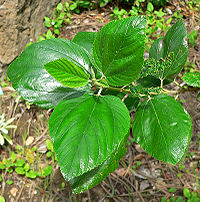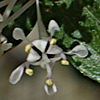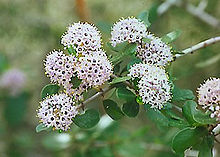- Ceanothus
-
Ceanothus 
Ceanothus americanus flowers Scientific classification Kingdom: Plantae (unranked): Angiosperms (unranked): Eudicots (unranked): Rosids Order: Rosales Family: Rhamnaceae Genus: Ceanothus
L.Species See text
Ceanothus L. (
 /ˌsiːəˈnoʊθəs/)[1] is a genus of about 50–60 species of shrubs or small trees in the buckthorn family Rhamnaceae. The genus is confined to North America, the center of its distribution in California, with some species (e.g. C. americanus) in the eastern United States and southeast Canada, and others (e.g. C. coeruleus) extending as far south as Guatemala. Most are shrubs 0.5–3 m tall, but C. arboreus and C. thyrsiflorus, both from California, can be small trees up to 6–7 m tall.
/ˌsiːəˈnoʊθəs/)[1] is a genus of about 50–60 species of shrubs or small trees in the buckthorn family Rhamnaceae. The genus is confined to North America, the center of its distribution in California, with some species (e.g. C. americanus) in the eastern United States and southeast Canada, and others (e.g. C. coeruleus) extending as far south as Guatemala. Most are shrubs 0.5–3 m tall, but C. arboreus and C. thyrsiflorus, both from California, can be small trees up to 6–7 m tall.Contents
Description
 Ceanothus arboreus illustrating the three parallel leaf veins characteristic of plants in this genus
Ceanothus arboreus illustrating the three parallel leaf veins characteristic of plants in this genus
The majority of the species are evergreen, but the handful of species adapted to cold winters are deciduous. The leaves are opposite or alternate (depending on species), small (typically 1–5 cm long), simple, and mostly with serrated margins.
Ceanothus species are easily identified by their unique leaf-vein structure shared by all plants within this genus. The leaves have three very prominent parallel veins extending from the leaf base to the outer margins of the leaf tips and the leaves are ovate in shape. The leaves have a shiny upper surface that feels "gummy" when pinched between the thumb and forefinger, and the roots of most species have red inner root bark.[2]
The flowers are white, greenish-white, blue, pale purple or pink, maturing into a dry, three-lobed seed capsule.
The flowers are tiny and produced in large, dense clusters that are reported to be intensely fragant almost to the point of being nauseating, and are said to resemble the odor of "boiling honey in an enclosed area". The seeds of this plant can lie dormant for hundreds of years, and Ceanothus species are typically dependent on forest fires to trigger germination of its seeds.[2]
Ecology
Ceanothus is a good source of nutrition for deer, specifically mule deer on the west coast. However, the leaves are not as nutritious from late spring to early fall as they are in early spring. Porcupines and quail have also been seen eating stems and seeds of these shrubs. The leaves are a good source of protein and the stems and leaves have been found to contain a high amount of calcium.
Distribution
Plants in this genus are widely distributed and can be found on dry, sunny hillsides from coastal scrub lands to open forest clearings up to 9,000 feet. These plants are profusely distributed throughout the Rocky Mountains from British Columbia south through Colorado, the Cascades of Oregon and California, and the Coastal Ranges of California.
Ceanothus velutinus is the most common member of this genus and is widespread throughout North America.[2]
Uses
Many species are popular garden ornamental plants, and dozens of hybrids and cultivars have been selected, such as Flexible Ceanothus, Ceanothus × flexilis Greene ex McMinn (C. cuneatus × C. prostratus).
Ceanothus velutinus was known as "red root" by many Native American tribes due to the color of the inner root bark, and was used as a medicine for treating lymphatic disorders, ovarian cysts, fibroid tumors, and tonsillitis. Clinical studies of the alkaloid compounds in Ceanothus velutinus has verified its effectiveness in treating high blood pressure and lymphatic blockages. [2]
Native Americans used the dried leaves of this plant as a herbal tea, and early pioneers used the plant as a substitute for black tea. Miwok Indians of California made baskets from Ceanothus branches. C. integerrimus has been used by North American tribes to ease childbirth. Ceanothus velutinus has been demonstrated to be very effective in relieving inflammation and irritation from infections of the mouth and throat.
Propagation
Propagation of Ceanothus is by seed, following scarification and stratification. Seeds are soaked in water for 12 hours followed by chilling at 1 °C for one to three months. It can also sprout from roots and/or stems. Seeds are stored in duff in large quantities. It is estimated that there are about two million seeds per acre in forest habitats. Seed are dispersed propulsively from capsules and, it has been estimated, can remain viable for hundreds of years. In habitat, the seeds of plants in this genus only germinate in response to range fires and forest fires.
Names
The Californian species are sometimes known as California Lilac, but species found elsewhere have other common names, such as New Jersey Tea for C. americanus (as its leaves were used as a black tea substitute during colonial times).[3] In garden use, most are simply called by their scientific names or an adaptation of the scientific name, such as Maritime Ceanothus for C. maritimus.
"Ceanothus" (four syllables, accented on the "o") was the name of a spiny Old World plant whose identity is now obscure.[4]
Selected species
- Ceanothus americanus L. - New Jersey Tea; Red Root
- Ceanothus arboreus Greene - Feltleaf Ceanothus
- Ceanothus confusus J.T. Howell - Rincon Ridge Ceanothus
- Ceanothus connivens Greene - Trailing Buckbrush
- Ceanothus cordulatus Kellogg - Whitethorn Ceanothus
- Ceanothus crassifolius Torr. - Hoaryleaf Ceanothus
- Ceanothus cuneatus (Hook.) Nutt. - Buckbrush
- Ceanothus cuneatus var. fascicularis (McMinn) - Hoover Sedgeleaf Buckbrush
- Ceanothus cuneatus var. rigidus (Nutt.) Hoover - Monterey Ceanothus
- Ceanothus cyaneus Eastw. - San Diego Buckbrush
- Ceanothus dentatus Torr. & Gray - Sandscrub Ceanothus
- Ceanothus divergens Parry - Calistoga Ceanothus
- Ceanothus diversifolius Kellogg - Pinemat
- Ceanothus fendleri Gray - Fendler's Ceanothus
- Ceanothus ferrisiae McMinn - Coyote Ceanothus
- Ceanothus foliosus Parry - Wavyleaf Ceanothus
- Ceanothus foliosus var. foliosus - Wavyleaf Ceanothus
- Ceanothus foliosus var. medius McMinn - Wavyleaf Ceanothus
- Ceanothus foliosus var. vineatus McMinn - Vine Hill Ceanothus
- Ceanothus fresnensis Dudley ex Abrams - Fresno Ceanothus
- Ceanothus gloriosus J.T. Howell - Point Reyes Ceanothus
- Ceanothus gloriosus var. exaltatus J.T. Howell - Point Reyes Ceanothus
- Ceanothus gloriosus var. gloriosus - Point Reyes Ceanothus
- Ceanothus gloriosus var. porrectus J.T. Howell - Mt. Vision Ceanothus
- Ceanothus greggii Gray - Desert Ceanothus
- Ceanothus greggii var. greggii - Desert Ceanothus
- Ceanothus greggii var. perplexans (Trel.) Jepson - Desert Ceanothus
- Ceanothus greggii var. vestitus (Greene) McMinn - Mojave Ceanothus
- Ceanothus griseus (Trel. ex B.L. Robins.) McMinn - Carmel Ceanothus
- Ceanothus hearstiorum Hoover & J.B. Roof - Hearst Ranch Buckbrush
- Ceanothus herbaceus Raf. - Jersey Tea
- Ceanothus impressus Trel. - Santa Barbara Ceanothus
- Ceanothus impressus var. impressus - Santa Barbara Ceanothus
- Ceanothus impressus var. nipomensis McMinn - Santa Barbara Ceanothus
- Ceanothus incanus Torr. & Gray - Coast Whitethorn
- Ceanothus integerrimus Hook. & Arn. - Deerbrush Ceanothus
- Ceanothus jepsonii Greene - Jepson Ceanothus
- Ceanothus jepsonii var. albiflorus J.T. Howell - Jepson Ceanothus
- Ceanothus jepsonii var. jepsonii - Jepson Ceanothus
- Ceanothus lemmonii Parry - Lemmon's Ceanothus
- Ceanothus leucodermis Greene - Chaparral Whitethorn
- Ceanothus maritimus Hoover - Maritime Ceanothus
- Ceanothus martinii M.E. Jones - Martin's Ceanothus
- Ceanothus masonii McMinn - Mason's Ceanothus
- Ceanothus megacarpus Nutt. - Bigpod Ceanothus
- Ceanothus megacarpus var. insularis (Eastw.) Munz - Island Ceanothus
- Ceanothus megacarpus var. megacarpus - Bigpod Ceanothus
- Ceanothus microphyllus Michx. - Littleleaf Buckbrush
- Ceanothus oliganthus Nutt. - Hairy Ceanothus
- Ceanothus ophiochilus Boyd, Ross & Arnseth - Vail Lake Ceanothus
- Ceanothus palmeri Trel. - Palmer Ceanothus
- Ceanothus papillosus Torr. & Gray - Wartleaf Ceanothus
- Ceanothus papillosus var. papillosus - Wartleaf Ceanothus
- Ceanothus papillosus var. roweanus McMinn - Wartleaf Ceanothus
- Ceanothus parryi Trel. - Parry Ceanothus
- Ceanothus parvifolius (S. Wats.) Trel. - Littleleaf Ceanothus
- Ceanothus pinetorum Coville - Coville Ceanothus
- Ceanothus prostratus Benth. - Prostrate Ceanothus
- Ceanothus pumilus Greene - Dwarf Ceanothus
- Ceanothus purpureus Jepson - Hollyleaf Ceanothus
- Ceanothus roderickii Knight - Pine Hill Buckbrush
- Ceanothus sanguineus Pursh - Redstem Ceanothus
- Ceanothus serpyllifolius Nutt. - Coastal Plain Buckbrush
- Ceanothus sonomensis J.T. Howell - Sonoma Ceanothus
- Ceanothus sorediatus Hook. & Arn. - Jimbrush Ceanothus
- Ceanothus spinosus Green Bark Ceanothus
- Ceanothus thyrsiflorus Eschsch. - Blueblossom
- Ceanothus tomentosus Parry - Woolyleaf Ceanothus
- Ceanothus velutinus Dougl. ex Hook. - Snowbrush Ceanothus
- Ceanothus velutinus var. hookeri M.C. Johnston - Hooker's Ceanothus
- Ceanothus velutinus var. velutinus - Snowbrush Ceanothus
- Ceanothus verrucosus Nutt. - Barranca Brush
See also
Notes
- ^ Sunset Western Garden Book, 1995:606–607
- ^ a b c d Edible and Medicinal Plants of the West, Gregory L. Tilford, ISBN 0-87842-359-1
- ^ Coladonato, Milo (1993). "Ceanothus americanus". Fire Effects Information System (online). Rocky Mountain Research Station, Fire Sciences Laboratory (Producer): U.S.D.A; Forest Service. http://www.fs.fed.us/database/feis/plants/shrub/ceaame/all.html. Retrieved August 22, 2010.
- ^ Elmore, Francis H. (1976). Trees and Shrubs of the Southwest Uplands. Western National Parks Association. pp. 195. ISBN 0-911408-41-X.
References
- University of Wisconsin–Stevens Point Plant Database: Ceanothus americanus
- Plants for a Future: Ceanothus integerrimus.
- Fire Effects Information: Ceanothus integerrimus
- Moerman, D. (1988). Native American Ethnobotany. Timber Press, Oregon.
Categories:- Ceanothus
- Flora of California chaparral and woodlands
- Flora of Baja California
Wikimedia Foundation. 2010.




